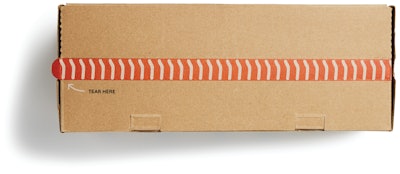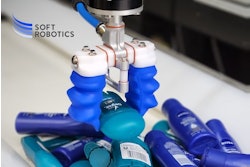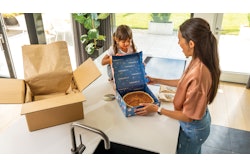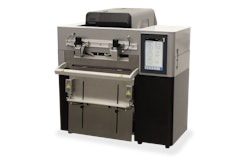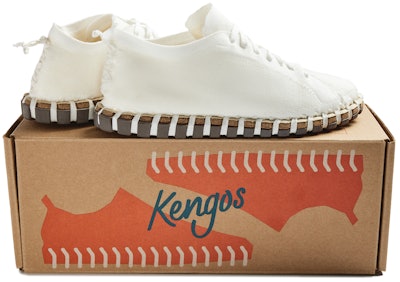
Sustainable footwear startup Kengos kicked off its e-commerce journey as soon as it first hung out a shingle in early 2021. There are a few others in the marketplace already, including entries from heavy hitters Nike and Adidas—Space Hippie and Parley, respectively—and a challenger brand in All Birds. But partners Dave Costello, CEO and Founder, and Micah Heftman, Chief Product Officer, say Kengo’s has a unique niche in the market identified.
“How could the market need another sustainable shoe brand?” Heftman asked the audience at Smithers’ E-Pack event in Chicago in November 2021. “Kengos exists to be a force for good in the fight against climate change, and we do that by producing the world’s most sustainable shoe. We chose footwear as our first product because it’s globally ubiquitous and it’s personally expressive—everyone has shoes, and everyone wants more shoes. The dirty secret in the industry is that it’s a wasteful and resource-intensive product to produce, and if we could just produce them in a more sustainable way we could have a huge impact since there are so many of them produced.”
This upstart challenger brand without a doubt has an interesting product and a unique entry into this market. A visit to the website will explain why in more detail, but the big picture is that the shoes are made from plants and can be considered vegan, using no animal products. They are mechanically held together with no glue or other adhesive, and only use five discrete components compared to the industry average of 30 to 50 components.
But my packaging-trained ears really perked up when I heard Heftman mention the amount of greenhouse gasses produced by the footwear industry, and how he believes that truly sustainable footwear requires drastic changes to existing supply chains and packaging norms.
And that’s where Kengos’ unique SIOC (ships in own container) e-commerce story began to unfold. Ultimately, Heftman and Kengos decided that if Kengos was going to disrupt the shoe market with a commitment to sustainability, it’d have to walk the walk with its packaging.
Packaging follows the product’s ‘North Star’
According to Heftman, the driving force for the entire Kengos concept was to follow two North Stars: “One is to use the fewest varieties and lowest volume of materials possible; to take away as much as we possibly could while still giving someone a shoe that’s incredible and comfortable and wearable,” he says. “And the second one is, of the remaining materials that we do have to use, make the highest percentage possible of materials used plant-based. Those two North Stars are what created the shoe, so when I went to create the packaging, we applied the exact same two driving forces.
“After all, I only make two things, I make shoes and I make shoeboxes,” Heftman says. “I’m a D2C e-comm brand; there are no other touch points. I have to have my packaging be just as good as my shoes. The package is the product. The shoes are more complex to manufacture than is the shoebox, but the shoebox is just as important.” 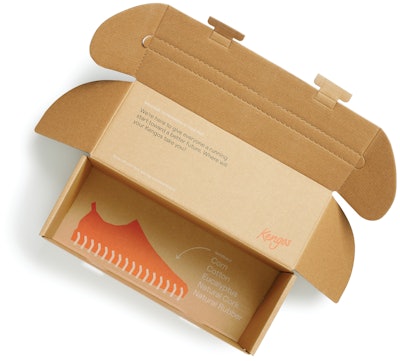 The corrugated SIOC shipper is printed in three colors on both sides, so all branding and messaging space is used as a billboard.
The corrugated SIOC shipper is printed in three colors on both sides, so all branding and messaging space is used as a billboard.
In a brief describing his vision for a shoebox, a memorable unboxing was identified as a key, as it can reinforce the brand for weeks or months in the customers’ mind. The shoebox would also have to serve as billboard space; other than the website, the shoebox is the only physical space that Kengos has for branding. He needed all surfaces doing branding work. Further demonstrating that the packaging is the product, the shoe doesn’t have any glue or adhesive, so the kraft corrugated shoebox couldn’t either. The same applied to size; since the shoes were as minimalistic as possible, the shoebox had to use as little material as possible. And finally, Heftman early recognized the inherent wastefulness of shipping “a box within a box.” All those factors combined to shine a spotlight on SIOC as the answer.
SIOC shoebox
Rather than turning to packaging professionals, Heftman relied on his own shoe business supply chain experience to develop shoebox that he says, like the shoes, are completely unique to the industry. The boxes lock together mechanically—a physical attribute extended from the mechanically stitched shoes themselves—and all available corrugated space is printed for branding and consumer engagement. He initially landed on 180 GSM weight corrugated with fluting between two layers of cardstock. After first experimenting with a lighter gauge, he realized the D2C channel needed to be more robust. And since that first round of kraft corrugated shoeboxes, Kengos continue to iterate smaller.
“Over the course of very early development, I was doing a little bit of shipping internationally to test out the box and I was getting a lot of broken boxes,” Heftman says. “I’d gotten to 180 GPM, and now my next box is an even a heavier weight, it’s the next step up from that. That thing is bulletproof. It uses three-tab mechanical construction instead of two. We’re just making it smaller and smaller, and more robust.”
Kengos shoes span 12 unisex sizes, and two shoebox sizes cover the whole range—one size for the largest shoes, the other for the smallest. Heftman says that in a perfect world, where he’s able to fully follow that reduced material North Star, he might have six different shoebox sizes, with each optimized to fit only two shoe sizes within millimeters. That would keep material usage at a minimum. But with packaging suppliers needing to tool up for each specific shoebox size, and with MOQs being too high for a single shoebox to work only for, say, sizes 6 and 7, that level of optimization isn’t yet practical. Two shoeboxes for a range of 12, though, was doable, and a good material reduction compromise for now. As the business grows and Heftman’s better able to justify MOQs and paying for tooling, look for Kengos to have six shoebox sizes for his 12 shoe sizes.
He points out that this creates wins across COGS (cost of goods sold), since: “less material is always cheaper,” he says. “Less material consumption, less volume, and lower dimensional weight is going to lead to cascading bottom-line wins. You consume lest material, in transit and in storage, you save on last-mile shipping, on labeling, on trim, on collateral, on all of these things that are the status quo [in the footwear industry]. But you don’t need any of that.”
